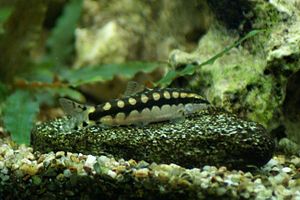Dwarf loach
| Dwarf loach | ||||||||||||
|---|---|---|---|---|---|---|---|---|---|---|---|---|

Dwarf loach ( Ambastaia sidthimunki ) |
||||||||||||
| Systematics | ||||||||||||
|
||||||||||||
| Scientific name | ||||||||||||
| Ambastaia sidthimunki | ||||||||||||
| ( Klausewitz , 1959) |
The dwarf loach ( Ambastaia sidthimunki , Syn . : Botia sidthimunki , Yasuhikotakia sidthimunki ), also called chessboard loach, is one of two known species of the genus Ambastaia .
features
Ambastaia sidthimunki is a very small species of the family of loaches (Botiidae), which can reach a length of up to 5.5 cm. The most striking feature is the high-contrast drawing of black longitudinal stripes on the back and on the flanks, which are connected to a checkerboard-like pattern on a yellowish-white background by also black transverse stripes that can extend beyond the longitudinal stripes of the flanks. The black stripe on the back of the dwarf loach is often divided lengthways by a whitish surface or a series of white spots and the stripes on the flanks can be dissolved into a series of dark, loosely connected spots.
Distribution, habitat and way of life
The loach was originally in a wide area in the catchment area of the Mae Nam Chao Phraya ("Chao Phraya River") and the Mae Nam Mae Klong ("Mae Klong River") in Thailand and possibly also the Mekong in the border area with Laos . Secure natural distribution areas are limited today (as of 2011) to the tributaries of the Mae-Klong in the province of Kanchanaburi .
The fish prefer flowing waters of the wooded lowlands and low mountain regions with moderately strong flow speeds and sandy to rocky subsoil.
Very little is known about the way fish live in their natural environment. They carnivore feed on insect larvae and benthonic microfauna .
Systematics
The species was first scientifically described in 1959 by Wolfgang Klausewitz under the name Botia sidthimunki . In 2002 it was transferred to the genus Yasuhikotakia by Teodor T. Nalbant together with the closely related species Botia nigrolineata . A few years later, however, molecular genetic studies showed that both species are more closely related to the genus Sinibotia than to other representatives of the genus Yasuhikotakia . Since there are also significant differences to the genus Yasuhikotakia in terms of body drawing , Maurice Kottelat placed both species in a new genus Ambastaia in 2012 .
Danger
The IUCN still lists the species in its Red List under the name Yasuhikotakia sidthimunki and has been evaluating it as endangered since 2011 ("Endangered"). In an older evaluation from 1996 it was classified as critically endangered. In the past, in addition to habitat loss through pollution and dam construction, overfishing for the international aquarium trade was cited as a major hazard.
The dwarf loach is protected in Thailand. For several years, state breeding programs for stocking in the ancestral waters have also been running in this country under the “Rehabilitation of Thai Local Fishes and Aquatic Animals Project”. The annual breeding rate in 2005 was estimated at around 10,000 individuals. Between 2003 and 2005, around 5,000 seedlings were released in the catchment area of the Nan River .
Aquaristics
The dwarf loach is a popular aquarium fish . They can live to be over 10 years old in captivity. The species is most active at water temperatures of 26-30 ° C. The fish live in schools and prefer the company of their own kind. Like all loaches, they like to dig in the ground, which should therefore consist of a grain that is not too sharp.
literature
- Hans A. Baensch , Rüdiger Riehl : Aquariums Atlas. Volume 1, Mergus Verlag, 1997, ISBN 3-88244-101-1 .
Individual evidence
- ^ WJ Rainboth: Fishes of the Cambodian Mekong. FAO Species Identification Field Guide for Fishery Purposes, Food and Agriculture Organization of the United Nations, Rome, 1996, ISBN 92-5-103743-4 , p. 134, ( preview ).
- ↑ a b c d M. Kottelat: Conspectus Cobitidum: An Inventory of the Loaches of the World (Teleostei: Cypriniformes: Cobitoidei). In: The Raffles Bulletin of Zoology , Supplement No. 26, 2012, pp. 1–199, ( digitized ).
- ↑ a b c d Yasuhikotakia sidthimunki in the IUCN Red List of Threatened Species 2019.2. Listed by: Vidthayanon C., 2011. Retrieved November 18, 2019 ..
- ^ A b C. Vidthayanon: Thailand Red Data: Fishes. Office of Natural Resources and Environmental Policy and Planning, Bangkok, 2005, ISBN 974-9929-87-X , p. 26, ( digitized ).
- ^ W. Klausewitz: Botia sidthimunki, a new loach from Thailand (Pisces, Cobitidae). In: Senckenbergiana Biologica , Volume 40, 1959, pp. 51-53.
- ^ V. Šlechtová, J. Bohlen, J. Freyhof & P. Ráb: Molecular phylogeny of the Southeast Asian freshwater fish family Botiidae (Teleostei: Cobitoidea) and the origin of polyploidy in their evolution. In: Molecular Phylogenetics and Evolution , Volume 39, 2006 (online 2005), pp. 529-541, ( digitized version ).
- ↑ M. Chaengkij: Thailand's concerns in endangered species and stock enhancement. In: JH Primavera, ET Quinitio, & MRR Eguia (Eds.): Proceedings of the Regional Technical Consultation on Stock Enhancement for Threatened Species of International Concern, Iloilo City, Philippines, 13-15 July 2005 , 2006, pp. 131-137 , ( Digitized version ).
- ↑ G. Ott: Loaches and loach-like ones. Albrecht Philler Verlag, Minden, 1988, ISBN 3-7907-0090-8 , pp. 12-16 & 63-64, ( digitized version ).
Web links
- Dwarf loach on Fishbase.org (English)